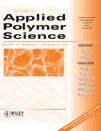Spectroscopic and thermogravimetric analysis of PANI/PPy composite polymer electrode: Its application to electrochemical investigation of pharmaceutical formulation
Abstract
The electrochemical preparation of polyaniline/polypyrrole (PANI/PPy) conducting polymer composite film on Tin oxide glass electrode from an aqueous solution containing a pyrrole monomer, p-toluenesulphonate electrolyte on to a polyaniline polymer doped with sulfuric acid, and sodium perchlorate is reported. The prepared PANI/PPy composite films were characterized by FTIR spectroscopy, UV–vis spectroscopy, and thermogravimetric analysis and scanning electron microscopy. Optical band gaps of these films were evaluated from UV–vis absorption studies. The optical band gap measurements of both direct and indirect allowed transition, showed a dual band gap for composite film. This type of dual band gaps for a composite polymer film was reported for the first time. The FTIR and UV–vis study showed the composite of PANI/PPy formed through the bond formation between PANI-PPY and dopant anions. Scanning electron microscopic studies confirmed the formation of composite with increased particle size. The TGA results showed that PANI/PPy polymer composite film was thermally stable than either PANI or PPy films. This PANI/PPy composite polymer electrode was used for cyclic voltammetric investigation of cefpodoxime proxetil drug in pharmaceutical formulation. The cyclic voltammetric data of composite electrode for cefpodoxime proxetil drug are compared with glassy carbon electrode. The current obtained on polymer electrode was around three time than that of glassy carbon electrode. The voltagramm also showed two reduction peaks C1 (∼57 μA) and C2 (∼70.0 μA) at potentials 1.2 and 1.6 V, respectively, at concentration 1 mM, which are absent for glassy carbon electrode. © 2008 Wiley Periodicals, Inc. J Appl Polym Sci, 2008




